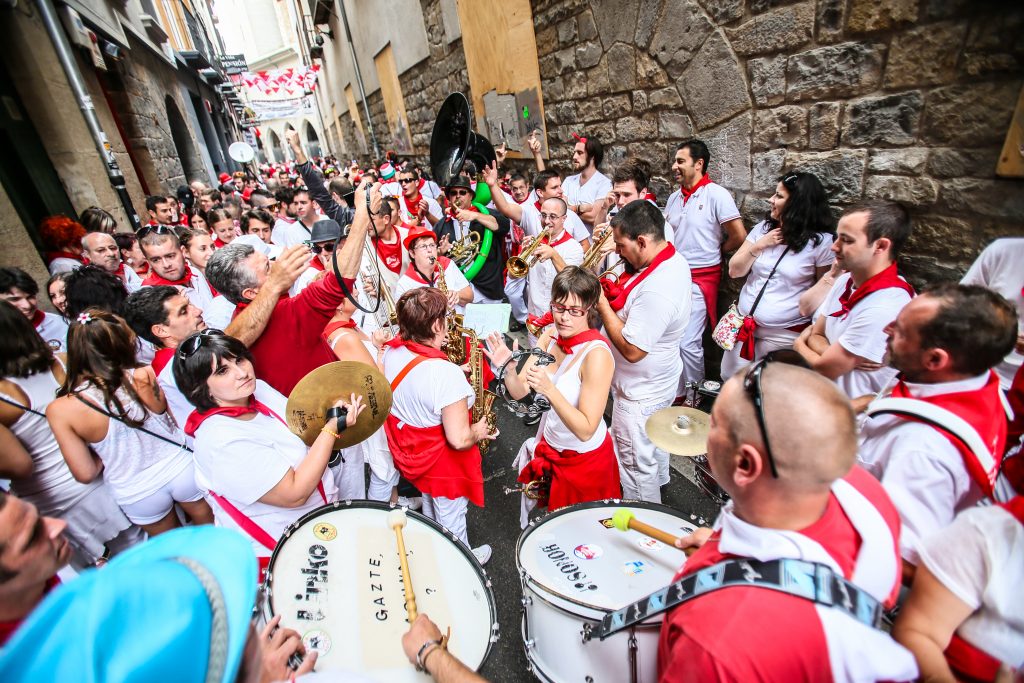
Image source: Sanfermin
Spain is a country where festivals are not just events – they’re a way of life. Each region bursts with unique traditions, from solemn religious processions to raucous street parties. This guide takes you through Spain’s most famous festivals, sorted by region, with their origins, locations, and timings. We’ve also included a festival calendar table and practical tips for booking hotels and travelling during these busy times. Let’s explore!
North of Spain Festivals: The Basque Country & Cantabria
Festivals of San Fermán in Pamplona
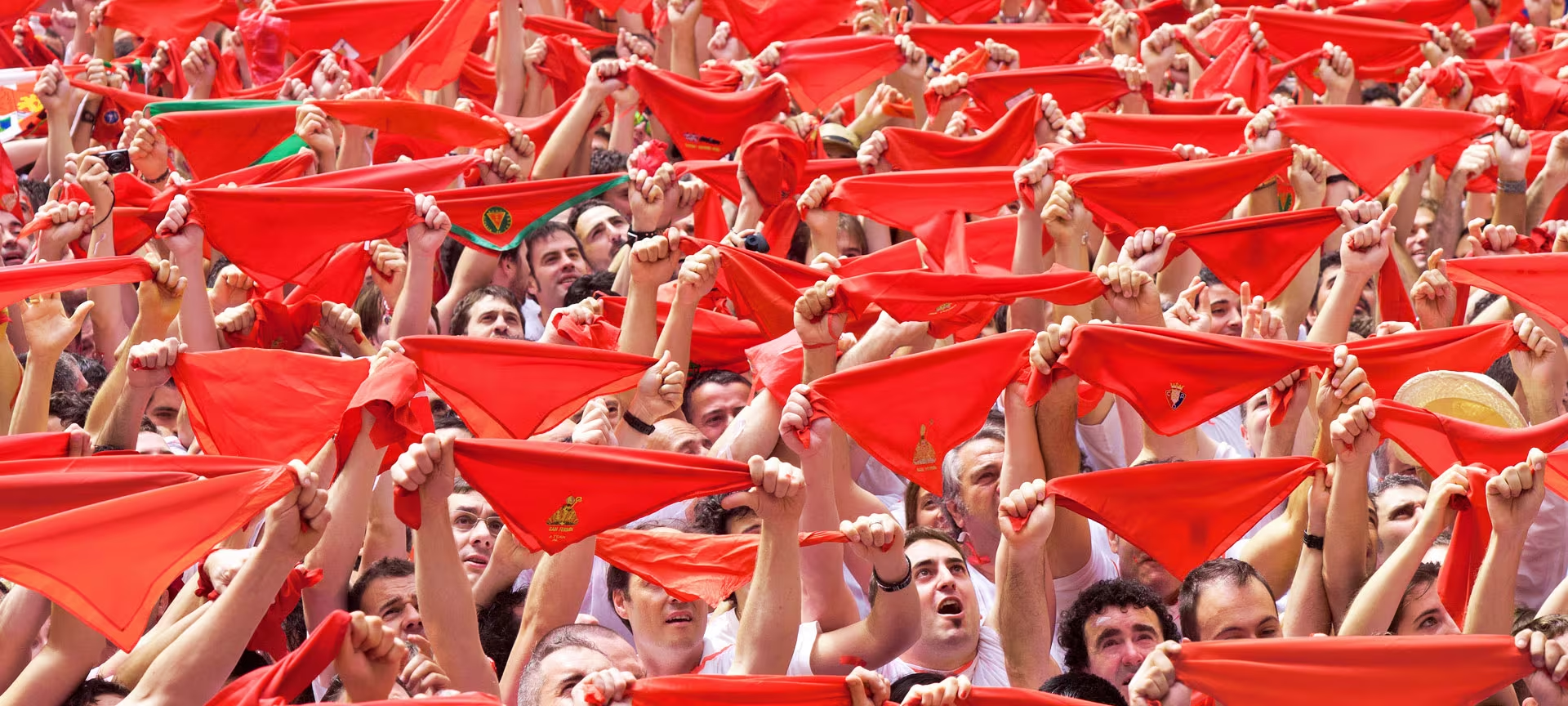
Image source: spain.info
The San Fermín festival, famously known for the thrilling Running of the Bulls, is one of Spain’s most iconic celebrations. Held annually in the historic city of Pamplona, in the northern region of Navarre, this vibrant festival combines tradition, religion, and adrenaline-fuelled excitement. While its roots are centuries old, San Fermín continues to draw visitors from around the world, eager to experience its unique blend of chaos and culture.
The origins of San Fermín date back to the Middle Ages, merging two separate events: religious ceremonies honouring Saint Fermín, a 3rd-century martyr, and traditional summer trade fairs. By the 16th century, these events were combined and moved to July, creating the festival we recognise today. Saint Fermín, now the patron saint of Navarre, remains central to the celebrations, with processions and masses held in his honour.
The festival officially kicks off at midday on July 6th with the Chupinazo—a rocket launched from Pamplona’s town hall square, sparking nine days of non-stop festivities. The most famous event, the Running of the Bulls, takes place every morning from July 7th to 14th. Participants dressed in white with red scarves sprint ahead of bulls along an 875-metre route through Pamplona’s narrow streets. Though thrilling, the event is not without risk, and it has sparked debates over animal welfare in recent years.
Beyond the runs, San Fermín is a whirlwind of music, dancing, and parades. Giant papier-mâché figures, street performers, and traditional Basque bands fill the city. Locals and visitors alike gather for communal feasts, fireworks, and late-night parties. The festival closes on July 14th with the melancholic song, sung by candlelight in the plaza.
La Mercè Festival (Barcelona)
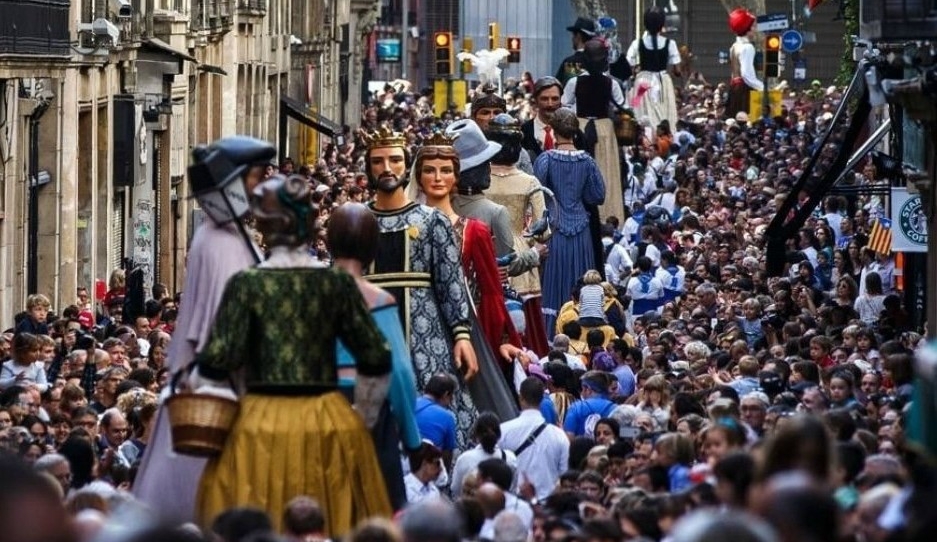
La Mercè is Barcelona’s biggest and most vibrant festival, celebrating the city’s patron saint, the Virgin of Mercy (Mare de Déu de la Mercè). Held every September, this week-long party transforms the streets into a whirlwind of music, dance, and Catalan traditions. While its roots are religious, today La Mercè is a joyful mix of culture, history, and community spirit, drawing visitors from across Spain and beyond.
The festival dates back to 1687, when Barcelona chose the Virgin of Mercy as its patron saint after she was believed to have saved the city from a plague of locusts. However, the modern festival as we know it began in 1902, evolving into an annual event that showcases Catalan identity. Though it honours a religious figure, La Mercè now focuses largely on local culture, with events funded by the city council to bring people together.
La Mercè takes place around September 24th, the feast day of the Virgin, with celebrations spanning five days. The festival kicks off with a grand opening speech by the mayor and a ceremonial procession. Highlights include the correfoc (fire run), where performers dressed as devils dart through the streets with sparklers and fireworks, and the awe-inspiring castellers (human towers), where teams build towering human pyramids—a tradition recognised by UNESCO.
You’ll also spot giant papier-mâché figures (gegants) parading through the squares, traditional sardana dances, and open-air concerts featuring everything from rock to classical music. The festival closes with a spectacular fireworks display near the Magic Fountain of Montjuïc, lighting up the night sky.
Batalla del Vino (Haro Wine Fight) & La Fiesta de San Mateo in LA RIOJA

Image Source: Fascinating Spain
La Rioja, Spain’s smallest region and world-famous for its wine, bursts into life with festivals that mix tradition, faith, and a healthy dose of grape-themed fun. Nestled in northern Spain along the Ebro River, this region celebrates its winemaking heritage and local saints with events ranging from lively street battles to harvest thanksgiving. While the capital, Logroño, hosts the biggest celebrations, villages across La Rioja add their own colourful twists to these timeless traditions.
The most iconic festival is La Fiesta de San Mateo (Harvest Festival), held in Logroño from 21st September for a week. Dating back to the 12th century, it began as a religious celebration to honour Saint Matthew and give thanks for the grape harvest. Today, it’s a joyful mix of wine-soaked revelry and cultural pride. The festival kicks off with the Pisado de la Uva (grape stomping) in the town square, where locals crush grapes barefoot in wooden vats—a nod to ancient winemaking. Parades, fireworks, and free wine tastings (verbenas) keep the atmosphere buzzing, while the region’s famed tapas bars serve up bites like patatas a la riojana (potato stew).
Another highlight is the Batalla del Vino (Wine Battle) in Haro, held every 29th June. Originating from a medieval dispute over land, it’s now a playful fight where thousands dress in white and drench each other with red wine. Trucks spray the crowd, and participants throw wine from bottles, buckets, or water pistols until everyone is dyed pink. The battle starts with a pilgrimage to a hillside hermitage, blending devotion with chaos.
Smaller towns add charm with events like Santo Domingo de la Calzada’s Medieval Market (May) or Cenicero’s Fiesta de la Vendimia (September), where grape-laden floats parade through the streets.
Festivals in Central Spain: The Valencian & Castellano Regions
In the Valencian region, the Festivales de Valencia are the highlight of the year. This vibrant celebration is centred around the city of Valencia and its surroundings, offering a blend of traditional festivals, cultural activities, and lively nightlife. Key events include the bullfighting festival in El Raval (La Riachuelo) and the traditional fiestas in Torrevieja.
The Castellano region, home to cities like Ciudad Real and Segovia, is celebrated by the Fiestas de la Almohadada. This festival marks the end of the Muslim rule over Spain and offers a rich cultural experience with horse-drawn carriage parades, traditional music performances, and delicious pastries like tapas.
Fiestas de la Almohadada
The Fiestas de la Almohadada (Festival of the Pillow) is a playful and quirky celebration held in the small town of Almagro, located in the Castilla-La Mancha region of central Spain. While not as famous as Spain’s larger festivals, this lighthearted event is beloved by locals for its mix of humour, tradition, and community fun. Centred around a mock “pillow fight” battle, the festival brings laughter and camaraderie to the streets every second weekend of August.
The origins of the Fiestas de la Almohadada are charmingly humble. Local legends say it began in the early 20th century as a children’s game during summer fairs, where kids would playfully hit each other with pillows to cool off in the heat. Over time, adults joined in, turning it into a town-wide tradition. The festival’s name—almohadada meaning “pillow strike”—reflects this cheeky spirit. Some also link it to historical reenactments of medieval battles, softened into a family-friendly spectacle.
The highlight is the Gran Batalla de Almohadas (Great Pillow Fight), where hundreds of residents and visitors, dressed in white nightshirts and caps, chase each other through Almagro’s Plaza Mayor, swinging pillows filled with feathers or soft stuffing. The rules are simple: no hard hits, and everyone ends the battle with a hug. The air fills with laughter and flying fluff, creating a surreal, snowy scene in summer.
Beyond the pillow fights, the festival includes a lively market selling handmade crafts and local treats like migas (fried breadcrumbs) and rosquillos (ring-shaped pastries). There are also parades with giant puppets, traditional music, and a Midnight Pillow Procession, where participants carry lantern-lit pillows to a ceremonial “sleep” under the stars.
La Tomatina (Buñol)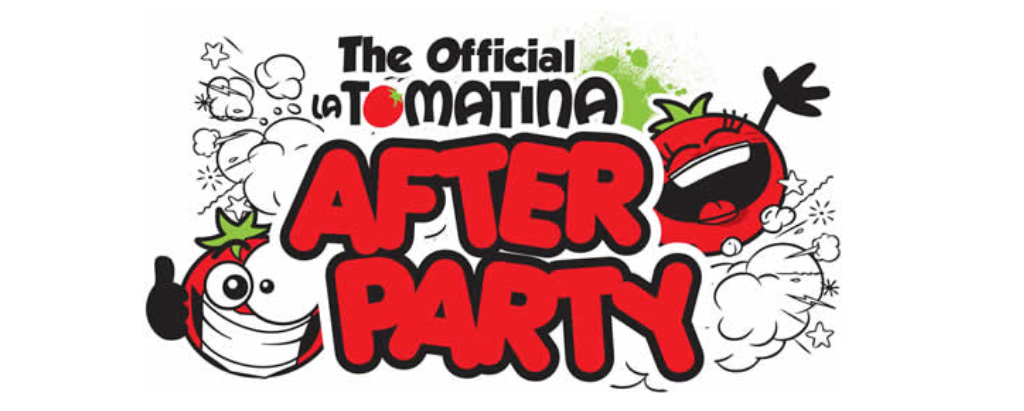

La Tomatina is Spain’s messiest, most colourful festival—a chaotic tomato battle that paints the streets of Buñol, a small town in Valencia, bright red every year. Held on the last Wednesday of August, this unique event draws thousands of visitors from around the globe, all eager to join the world’s biggest food fight. What began as a local scuffle has grown into a joyful, if slightly surreal, celebration of fun and community.
The origins of La Tomatina are delightfully unclear. Most stories trace it back to the mid-1940s, when a group of young people, caught up in a lively street parade, began hurling tomatoes from a nearby market stall during a spontaneous squabble. Despite being briefly banned in the 1950s, locals fought to revive it, and by the 1980s, it had become an official festival. Today, it’s a highlight of Spain’s festival calendar, with strict rules to keep things safe—like squashing tomatoes before throwing and avoiding hard objects.
The action kicks off after the palo jabón, a humorous pre-game where participants try to climb a greased pole to grab a ham. Once someone succeeds, trucks dump over 120 tonnes of overripe tomatoes into the streets, and the hour-long frenzy begins. The town’s 9,000 residents welcome up to 20,000 tomato-throwers, who wear old clothes and goggles for the occasion. After the battle, fire trucks hose down the streets, and everyone heads to the river or local pools to wash off.
Though the tomato fight is the star, La Tomatina is part of a week-long fiesta with live music, parades, and paella competitions. The tomatoes themselves—unfit for sale—are sourced from Extremadura, reducing waste.
La Tomatina isn’t just about hurling fruit; it’s a testament to Spain’s love of lively, unconventional traditions. Whether you’re dodging tomatoes or laughing covered in pulp, this one-of-a-kind festival is an unforgettable way to let loose—just don’t wear your best shirt!
Las Fallas Valencia
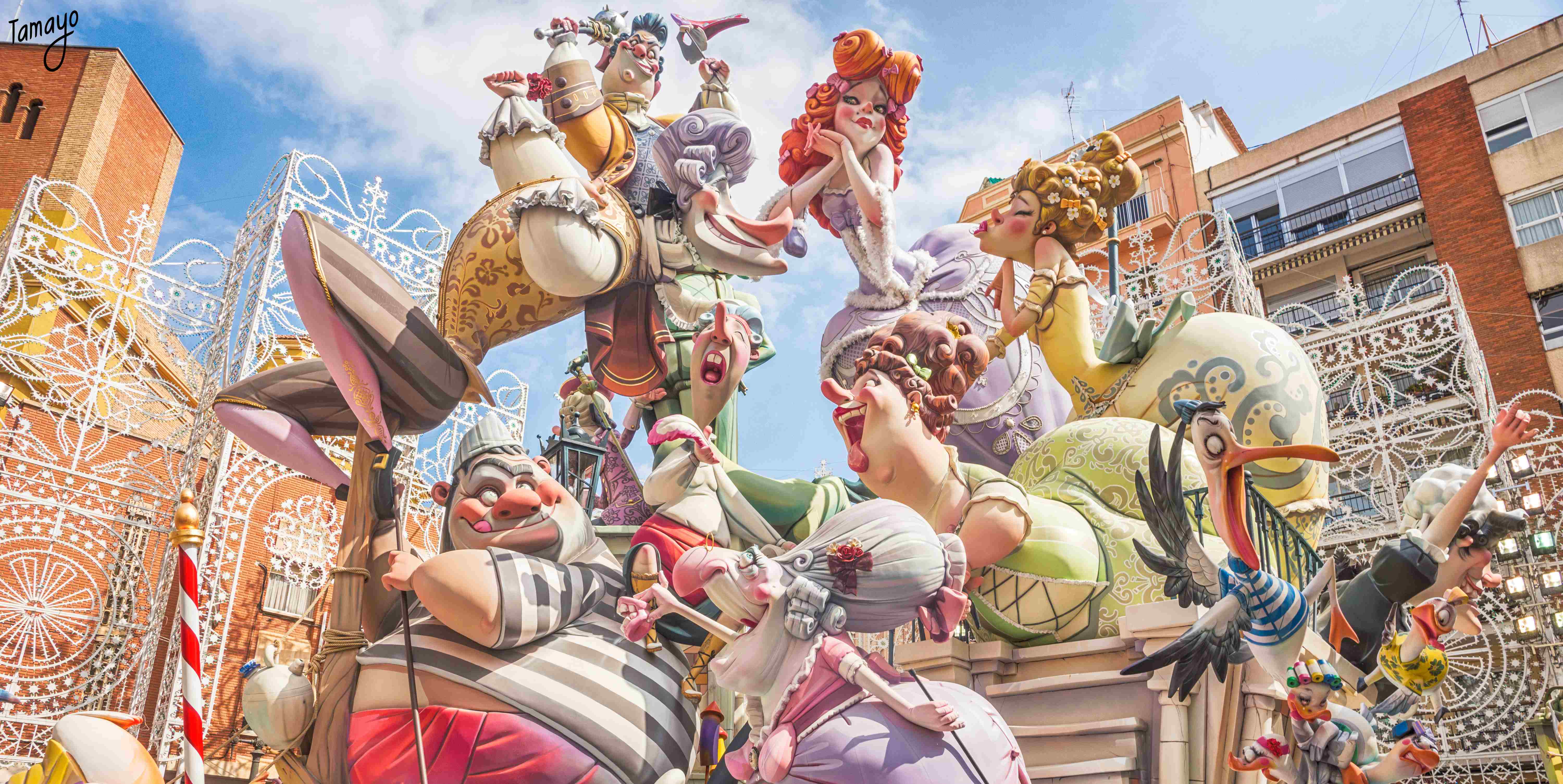
Image credit: Visit Valencia
Las Fallas is Valencia’s most explosive and visually stunning festival, lighting up the city every March with towering statues, thunderous fireworks, and fiery bonfires. Held from 15th to 19th March, this UNESCO-listed celebration blends art, satire, and tradition, drawing crowds eager to witness its unique mix of chaos and creativity.
The origins of Las Fallas trace back to the Middle Ages, when carpenters burned leftover wood and old lamps to celebrate the arrival of spring, coinciding with Saint Joseph’s Day (19th March), the patron saint of carpenters. Over time, this humble ritual evolved into a grand festival. By the 18th century, communities began crafting satirical figures from wood and papier-mâché, poking fun at politicians or current events. These figures, called ninots, now form part of the elaborate fallas—giant statues up to 30 metres tall, displayed across the city.
The festival kicks off on 15th March with the plantà, when teams work overnight to erect hundreds of fallas. Each day at 2pm, the streets shake with the mascletà, a deafening fireworks display. Traditional parades, music, and the ofrenda de flores (flower offering) to the Virgin Mary add to the festivities, with locals dressed in vibrant Valencian costumes.
The climax comes on the final night, the cremà, when all the fallas are set ablaze. The largest statue burns last, lighting the sky in a breathtaking spectacle. Only one ninot is saved by public vote, displayed in the Fallas Museum.
While the flames are unforgettable, Las Fallas is also a celebration of community and artistry. Families, artists, and neighbourhood groups spend months crafting the statues, blending humour and craftsmanship. Today, it remains a proud symbol of Valencia’s identity—a fiery mix of tradition, rebellion, and sheer fun. Just don’t forget earplugs for the mascletà!
South of Spain Festivals: Andalucía & Extremadura
In Andalucía, the Festivales de San Juan de Antequera in Málaga stand out as one of the most colourful events in Spain. This grand festival celebrates the town's rich maritime heritage with Procession parades through the city streets, live music performances, and a vibrant market where traditional foods like tapas are sold. Extremadura, known for its stunning mountain landscapes, offers the Festivales de El Escorial, which include horse-drawn carriage rides through the historic town of El Escorial. This event highlights the region's rich cultural heritage with workshops on royal art and traditions, making it a must-attend for history enthusiasts.
Festivales de San Juan de Antequera
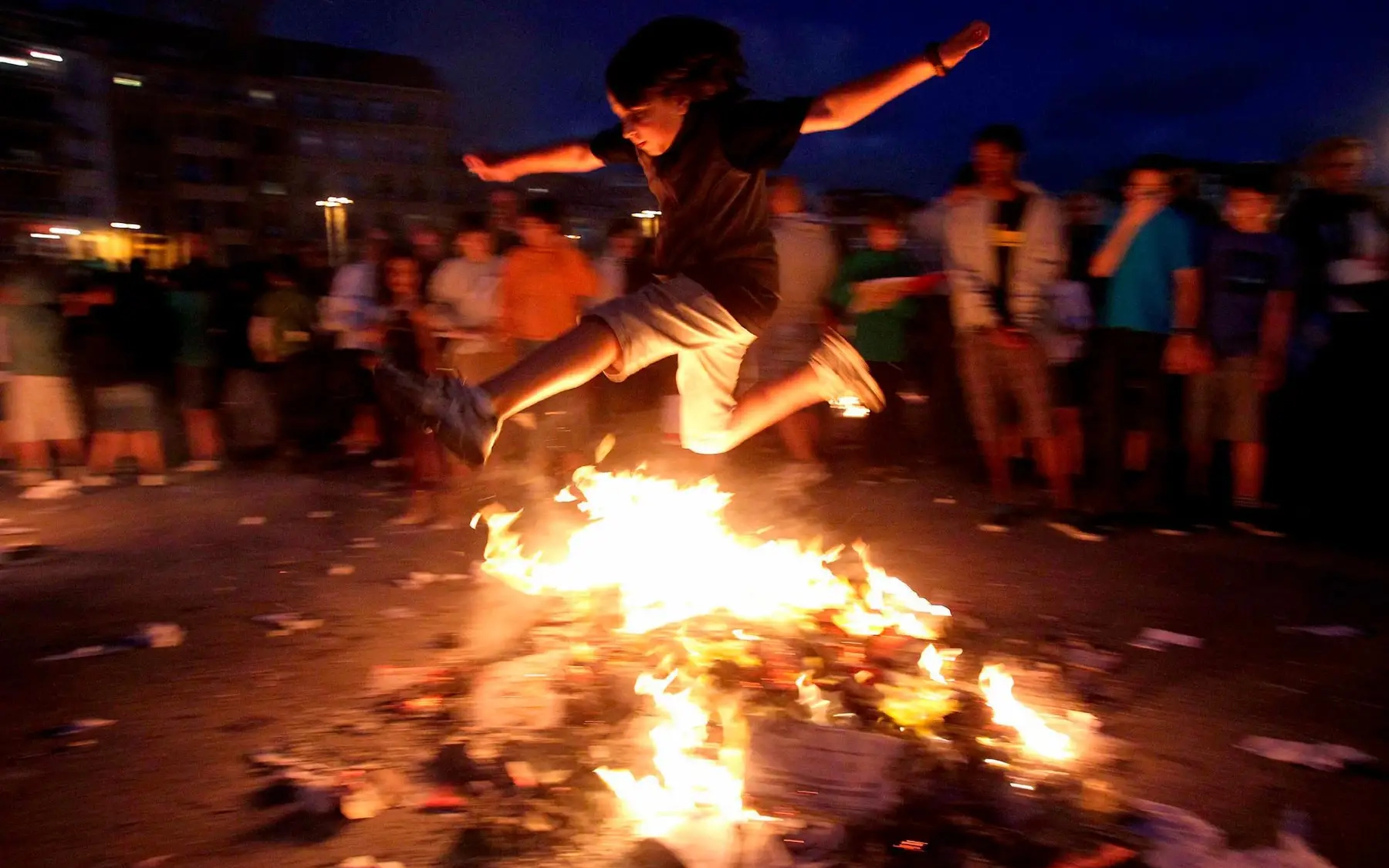
Image source: Amoureux-Andalousie
The Festivales de San Juan de Antequera, celebrated in the historic town of Antequera in Andalusia, is a vibrant mix of fire, folklore, and tradition marking the summer solstice. Held every year around 23rd and 24th June, this festival lights up the streets with bonfires, music, and a lively atmosphere, blending ancient pagan rituals with Christian devotion to Saint John the Baptist. While smaller than Spain’s more famous fiestas, it offers an authentic glimpse into Andalusian culture and community spirit. The origins of San Juan in Antequera stretch back centuries, rooted in pre-Christian solstice celebrations that welcomed summer with fire—a symbol of purification and renewal. Over time, these pagan customs merged with the Christian feast day of Saint John, creating a unique local tradition. Antequera, known for its UNESCO-listed Dolmen archaeological sites, adds its own historical flair to the festivities, tying the festival to the town’s deep connection with its ancient past.
The heart of the celebration is the Noche de San Juan (St. John’s Eve) on 23rd June. Locals and visitors gather around bonfires in squares and along the river, leaping over flames for good luck or writing wishes on paper to burn. The night buzzes with live music, flamenco dancing, and families sharing plates of grilled meats, migas (fried breadcrumbs), and sweet roscos (doughnuts). At midnight, fireworks often light up the sky near landmarks like the Santa María Church, adding magic to the warm summer night.
Festivales de El Escorial
The Festivales de El Escorial, set against the grand backdrop of the Royal Monastery of San Lorenzo de El Escorial, offer a captivating blend of history, culture, and art in this picturesque town near Madrid. Held annually in late August and early September, the festival honours San Lorenzo (Saint Lawrence), the town’s patron saint, while celebrating the area’s rich heritage. Though quieter than Spain’s rowdier fiestas, it charms visitors with its mix of solemn tradition and lively creativity.
The origins of the festival are tied to the town’s deep-rooted history. Built around the 16th-century monastery—a UNESCO World Heritage Site commissioned by King Philip II—El Escorial’s festivities likely began as religious events marking Saint Lawrence’s feast day on 10th August. Over time, these evolved to include cultural activities, reflecting the town’s role as a hub of Spanish history and art. Today, the festival balances reverence for the past with music, theatre, and local customs.
Highlights include the procession of San Lorenzo, where a statue of the saint is carried through the cobbled streets, accompanied by traditional music and floral offerings. The monastery itself becomes a stage for classical concerts and exhibitions, its historic walls adding grandeur to performances. Meanwhile, the town buzzes with craft markets, street theatre, and open-air film screenings, often under the warm summer sky.
A unique feature is the Medieval Market, where the town square transforms into a bustling scene of artisans, jugglers, and food stalls, reviving the atmosphere of centuries past. Locals and visitors dine on hearty dishes like cocido madrileño (stew) or sweet rosquillas (doughnuts), while children try their hand at ancient games.
Semana Santa (Holy Week)
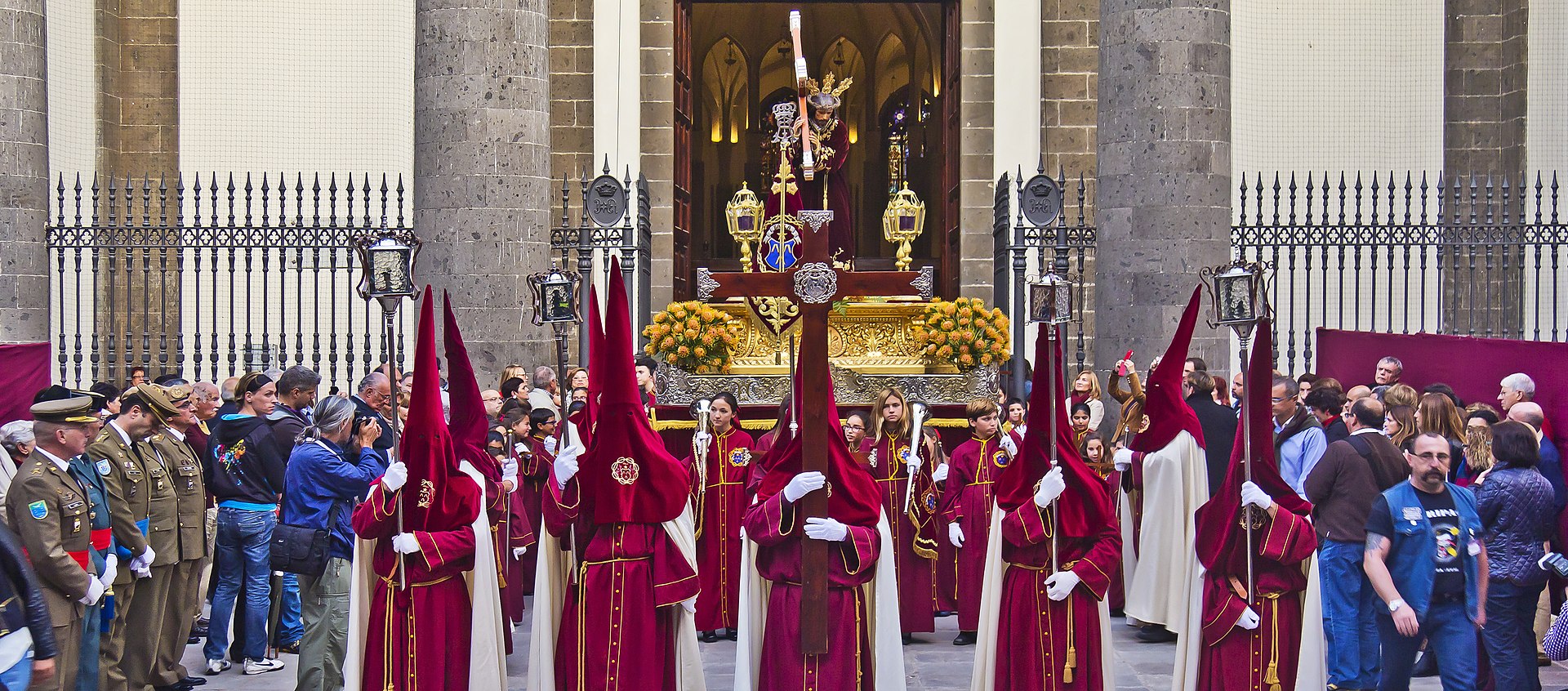
Image source: Wikipedia
Semana Santa, or Holy Week, is one of Spain’s most deeply rooted and dramatic festivals, marking the final days of Jesus Christ’s life through solemn processions, music, and centuries-old traditions. Celebrated across the country in the week leading up to Easter Sunday (dates vary between March and April), it blends religious devotion with cultural heritage, creating an atmosphere of reflection and awe. While observed nationwide, cities like Seville, Malaga, Valladolid, and Granada are famed for their particularly striking celebrations.
The origins of Semana Santa date back to the Middle Ages, when Catholic brotherhoods began organising processions to share Bible stories with those who couldn’t read. By the 16th century, these groups—still central to the festival today—started carrying ornate floats (pasos) bearing religious statues through the streets. The tradition evolved over time, mixing Spanish artistry with emotional storytelling, and remains a powerful display of faith and community.
Each day of Semana Santa features processions led by robed participants (nazarenos), whose pointed hoods symbolise penance. The floats, often centuries old, are carried by teams called costaleros, who navigate narrow streets in near-silence, accompanied by mournful brass bands. In Seville, crowds gather for the early-hours Madrugá processions, while Malaga’s massive floats require up to 300 carriers. Valladolid is known for its museum-quality statues, and Zamora for hauntingly beautiful chants (saetas) sung from balconies.
Though deeply spiritual, Semana Santa also unites locals and visitors in shared wonder. Streets fill with the scent of incense, the glow of candles, and the murmur of prayer. The week peaks on Good Friday, marking Christ’s crucifixion, before ending with Easter Sunday’s joyful celebrations. Seville’s processions are the most famous, with routes passing the Gothic Cathedral. Arrive early to secure a good spot.
Feria de Abril (Seville)
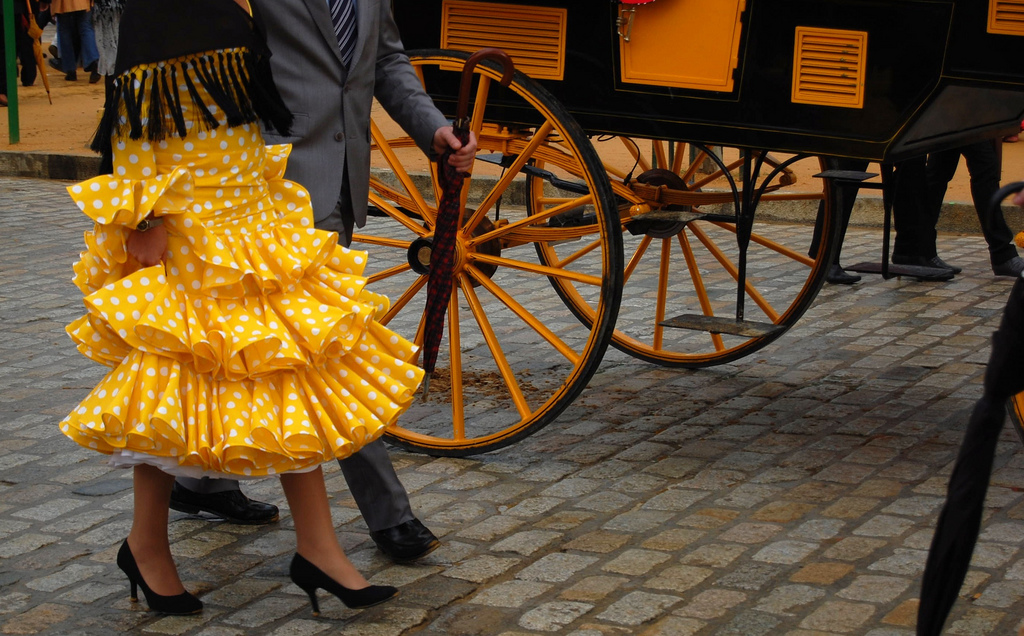
Image source: Wikipedia
Two weeks after Easter, Seville’s Feria de Abril lights up with flamenco, horses, and sherry. What began in 1847 as a livestock fair is now a week-long party. Women wear colourful flamenco dresses, men don traditional suits, and the fairgrounds buzz with music and dancing. Don’t miss the casetas (private tents) serving pescaíto frito (fried fish) and rebujito (sherry mixed with lemonade).
The Feria de Abril in Seville is a whirlwind of colour, music, and Andalusian charm, transforming the city into a lively celebration of spring. Held for seven days each April (usually two weeks after Easter), this iconic festival began as a livestock fair in 1847 but has blossomed into Spain’s most dazzling display of traditional culture. Think flamenco dresses, horse-drawn carriages, and non-stop dancing—all under rows of glowing paper lanterns.
The origins of the Feria trace back to a royal-approved cattle market organised by two local councillors. By the late 19th century, the event had shifted focus from trade to celebration, with tents set up for eating, drinking, and socialising. Today, over 1,000 casetas—many privately owned by families or clubs—fill the vast Real de la Feria fairground. The festival kicks off with the alumbrao, the lighting of the entrance gate, a spectacular structure themed differently each year.
Sevillanos embrace tradition during the Feria. Women wear flamboyant flamenco dresses with ruffles and flowers, while men don smart suits or traditional traje corto (short jackets). Days start with parades of horses and carriages, followed by lunches of pescaíto frito (fried fish) and tapas. As night falls, the fairground erupts with sevillanas dancing, clapping, and singing, fuelled by rebujito (a mix of sherry and lemonade).
Though rooted in history, the Feria is also about community. Public casetas welcome visitors, and the streets buzz with amusement rides and street performers. The festival closes with fireworks, leaving the city glowing with memories.
More than just a party, the Feria de Abril is the heart of Sevillian identity—a joyful mix of pride, tradition, and sheer fun. Whether you’re sipping sherry in a caseta or swaying to a sevillana, this is Andalusia at its most magical. Just be ready to dance till dawn!
Festivals in Canary Islands
Carnival of Santa Cruz de Tenerife
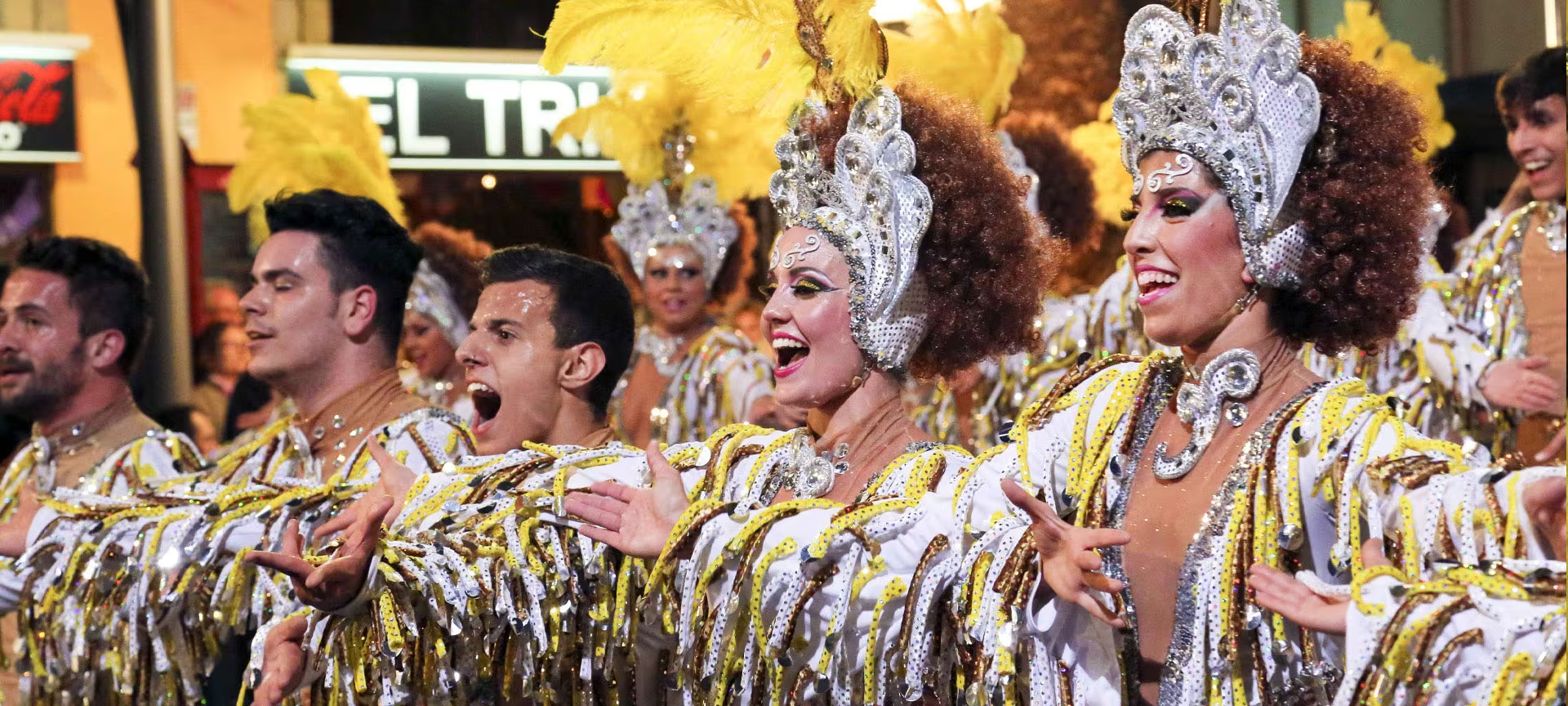
Image source: spain.info
Held annually in February or March (dates shift with Easter), Tenerife’s capital hosts one of the world’s largest carnivals, rivalling Rio de Janeiro. This two-week spectacle transforms the capital of Tenerife into a playground of parades, costumes, and non-stop dancing. The “Burial of the Sardine” marks the end, with a humorous funeral procession. The carnival’s roots trace back to 18th-century masquerade balls.
The carnival’s roots stretch back to the 18th century, influenced by European masquerade traditions and pre-Lent celebrations. However, it truly flourished in the 20th century, despite being banned during Spain’s Franco dictatorship. After the regime fell, the carnival exploded back to life, becoming a symbol of joy and resistance. Today, it’s even recognised by Guinness World Records for its sheer scale.
The festivities kick off with the Opening Parade, a dazzling march of dancers, musicians, and floats. The highlight is the Queen Election Gala, where contestants wear enormous, feather-covered costumes weighing up to 150kg. The streets then fill with murgas (satirical musical groups) and comparsas (dance troupes), performing humorous or political acts. The main event, the Coso Parade, sees over 100 groups parade along the seafront, their sequined outfits glinting under the sun.
By night, the party moves to the streets, where mogollones (spontaneous street parties) keep energy high until dawn. The carnival wraps up with the Burial of the Sardine, a mock funeral where a giant papier-mâché sardine is burned, marking the end of the fun.
Spain Festival Calendar
Festival | Time | City/Region | Key Details |
La Tomatina | Last Wed of August | Buñol (Valencia) | Giant tomato fight in the streets. |
Las Fallas | 15th–19th March | Valencia | Burning of satirical statues. |
Semana Santa | March/April (Easter) | Seville, Malaga, Granada | Religious processions with ornate floats. |
Feria de Abril | Two weeks after Easter | Seville | Flamenco, horses, and sherry tents. |
San Fermín | 6th–14th July | Pamplona (Navarre) | Bull runs and all-night street parties. |
La Mercè | 24th September | Barcelona | Fire runs, human towers, and concerts. |
Tenerife Carnival | February/March | Santa Cruz de Tenerife | Costume parades and salsa music. |
Feast of Saint James | 25th July | Santiago de Compostela | Pilgrim celebrations and fireworks. |
Batalla del Vino | 29th June | Haro (La Rioja) | Wine fight at cliffside location. |
Spanish Festivals Locations & Timing
Each festival has its own schedule, dates can shift slightly year to year (especially those tied to Easter). Always confirm exact dates before planning!
- Festivals of San Fermín (Pamplona, Navarre)
- Start: 6th July
- Duration: 9 days
- La Mercè Festival (Barcelona, Catalonia)
- Start: ~24th September (feast day of La Mercè)
- Duration: 5 days
- Batalla del Vino (Haro, La Rioja)
- Start: 29th June
- Duration: 1 day
- La Fiesta de San Mateo (Logroño, La Rioja)
- Start: 21st September
- Duration: 1 week
- Fiestas de la Almohadada (Almagro, Castilla-La Mancha)
- Start: Second weekend of August
- Duration: 3 days (weekend)
- La Tomatina (Buñol, Valencia)
- Start: Last Wednesday of August
- Duration: 1 day (main event)
- Las Fallas (Valencia, Valencia)
- Start: 15th March
- Duration: 5 days (ends 19th March)
- Festivales de San Juan de Antequera (Antequera, Andalusia)
- Start: 23rd June (Noche de San Juan)
- Duration: 2 days
- Festivales de El Escorial (San Lorenzo de El Escorial, Madrid)
- Start: Late August
- Duration: ~2 weeks (into early September)
- Semana Santa (Holy Week) (Nationwide; notable in Seville, Málaga, Valladolid)
- Start: Week before Easter Sunday (March/April)
- Duration: 1 week
- Feria de Abril (Seville, Andalusia)
- Start: Two weeks after Easter
- Duration: 7 days
- Carnival of Santa Cruz de Tenerife (Santa Cruz de Tenerife, Canary Islands)
- Start: February/March (varies with Easter)
- Duration: ~2 weeks
Must-Try Festivals: What to Experience
- La Rifaña de Cantabria: Indulge in the festival's vibrant atmosphere with colorful floats, delicious pastries like "churros," and live music that captures the essence of Spanish folklore.
- El Clásico de San Fermán de Deia: Watch a human bullfighting event that offers an unforgettable experience combining tradition with modern entertainment. Don't miss theOnorado performance where volunteers defend the bull against the crowd.
- Festivales de València: Enjoy authentic tapas bars, visit patios filled with colorful tables, and participate in interactive workshops that showcase Spanish craftsmanship and creativity.
- Festivales de la Almohadada: Experience the cultural richness of this region through horse-drawn carriage parades, traditional music performances, and a chance to learn about the history behind the famous "Almohads," the coins used during the Muslim rule over Spain.
- Festivales de San Juan de Antequera: Discover Málaga's vibrant festival atmosphere withProcession parades through the heart of the city streets, live music performances at outdoor stages, and a chance to enjoy authentic Andalusian cuisine in traditional restaurants.
Tips for Booking Hotels and Travelling During Festivals
Booking Accommodation
Spain’s festivals draw huge crowds, so planning is essential. For major events like San Fermín or Semana Santa, book hotels 6 months in advance. Prices soar during festivals, so consider staying in nearby towns. For example, during San Fermín, look for hotels in Estella or Tafalla, both 30 minutes from Pamplona. Use trusted booking platforms like Trip.com, but check reviews mentioning noise levels – festivals can be loud!
If you’re on a budget, hostels or guesthouses offer affordable options. For a unique experience, monasteries along the Camino de Santiago provide simple lodging for pilgrims. Always check cancellation policies in case plans change.
Travelling to Festivals
Spain’s trains and buses are efficient but get crowded during festivals. Book tickets early through Renfe (trains) or ALSA (buses). For example, trains from Madrid to Seville for Feria de Abril sell out quickly. If flying, airports in Barcelona, Madrid, and Malaga have good connections, but regional airports like Valencia or Bilbao may offer cheaper flights.
Driving? Parking in city centres is limited during festivals. Use park-and-ride services or book hotels with parking. In smaller towns like Buñol (La Tomatina), arrive early – roads close before the tomato fight.
Embracing Festivals in Spain
Spain's festivals are not just cultural celebrations but also opportunities for adventure, discovery, and reflection. From the grand processions of Cantabria to the lively bullfighting of Extremadura, each festival offers a unique slice of Spanish life. By planning your visits carefully and experiencing these events firsthand, you'll gain a deeper understanding and appreciation of Spain's rich cultural tapestry.
So, lace up your boots, pack your bags, and get ready for an unforgettable journey that will be filled with joy, surprises, and memories that will last a lifetime. Happy travels!







